By Sofia Santos & Benjamin Pitet
Ukrainian refugees are presented with the illusion of choice from the moment of their capture until their involuntary settlement in Russian territory. They are trapped in a Kafka-esque system working against them. Kept under the watchful eyes of the invading forces from the moment of their capture until their forceful placement in Russian territory, there is no safe way to escape a process in which the wrong answer can cost them their lives.
According to the United Nations High Commissioner for Refugees, as of June 28, there are almost 5.5 million Ukrainian citizens displaced across Europe. Over over 1.4 million of them have reportedly crossed the border to Russia since February 24.
Despite agreeing to open humanitarian corridors for the safe evacuation of Ukrainian civilians from Russian controlled territory, there is overwhelming evidence of their unwillingness to do so. This includes several reported cases of private vehicles and evacuation buses being targeted by the Russian military. This has resulted in the injury, death, or the abduction of their occupants.
With limited or no safe options to escape their situation, many Ukrainians are forced to board Russian evacuation buses taking them to filtration camps, controlled by armed pro-Russian forces.
In these camps refugees are interrogated, threatened, verbally abused and, in some cases, physically assaulted. Various reports also indicate that some people, who do not pass interrogation, simply disappear.
After filtration, the Ukrainian citizens are transported across the border to Russian Temporary Accommodation Centres.
Here, they are given promises on what to expect once they choose a city to live. These promises are short lived; many refugees reported feeling deceived upon arrival in a different location. Most of the promises told to the Ukrainian civilians are either untrue or have so many conditions that they become unattainable.
Some refugees manage to return to Europe, sometimes by travelling over 7000 Km after being relocated to the far East of Russia.
However, many more are left in despair as they are unable to get jobs to afford their new life in a forced relocation.
This report aims to provide open source evidence of the reality lived by these individuals as they are unwillingly taken from their homeland, and forcefully relocated towards the Russian Federation.
PLEASE NOTE:
This report contains descriptions of graphic imagery / violence which some readers may find distressing. Additionally, where graphic footage has been verified by EoR investigators it is linked in the footnotes with the explicit warning of “graphic footage”.
Evacuation of civilians from war zones
Despite agreeing to open humanitarian corridors allowing the safe passage of Ukrainian civilians on March 9, the Russian military has given enough evidence of their unwillingness to honor the agreement. Numerous evacuation buses, attempting to take Ukrainian citizens from Russian controlled territory, have been a target of Russian forces for the past several months. Sometimes with deadly outcomes.
On March 30, Irina Vereshchuk, the Ukrainian Vice Prime Minister, claimed in a video on her Facebook page that Russia was denying the safe passage of humanitarian aid in Vasylivka, Zaporizhzhia Oblast, as well as blocking Ukrainian buses attempting to evacuate citizens from Russian controlled territory.
Just a week earlier, on March 23, Lyudmyla Leontiyivna Denisova, the head of the Ukrainian Commission for Human Rights, shared similar reports on her Facebook page by saying:
“Near Vasylivka, Zaporizhia Oblast, the racists blocked the road and created a multi-kilometer traffic jam from the cars of refugees from Mariupol. There are evacuation buses in the column, which take people from Berdyansk to Zaporizhia. Ambulances with injured children are also in line. People have been without water and food for two days now. The Russian occupiers are conducting an in-depth inspection of those crossing their checkpoint and creating obstacles to the movement of the column.”
On April 15, Ukrainian news outlets reported that, on April 14, the Russian military opened fire on evacuation buses in the village of Borova, Kharkiv Oblast, killing 7 civilians and injuring 27 others. This small village, circled in dark blue on the map below, was, at the time of the incident, considered a “conflict settlement”, surrounded by Russian occupied territory since the beginning of the invasion.
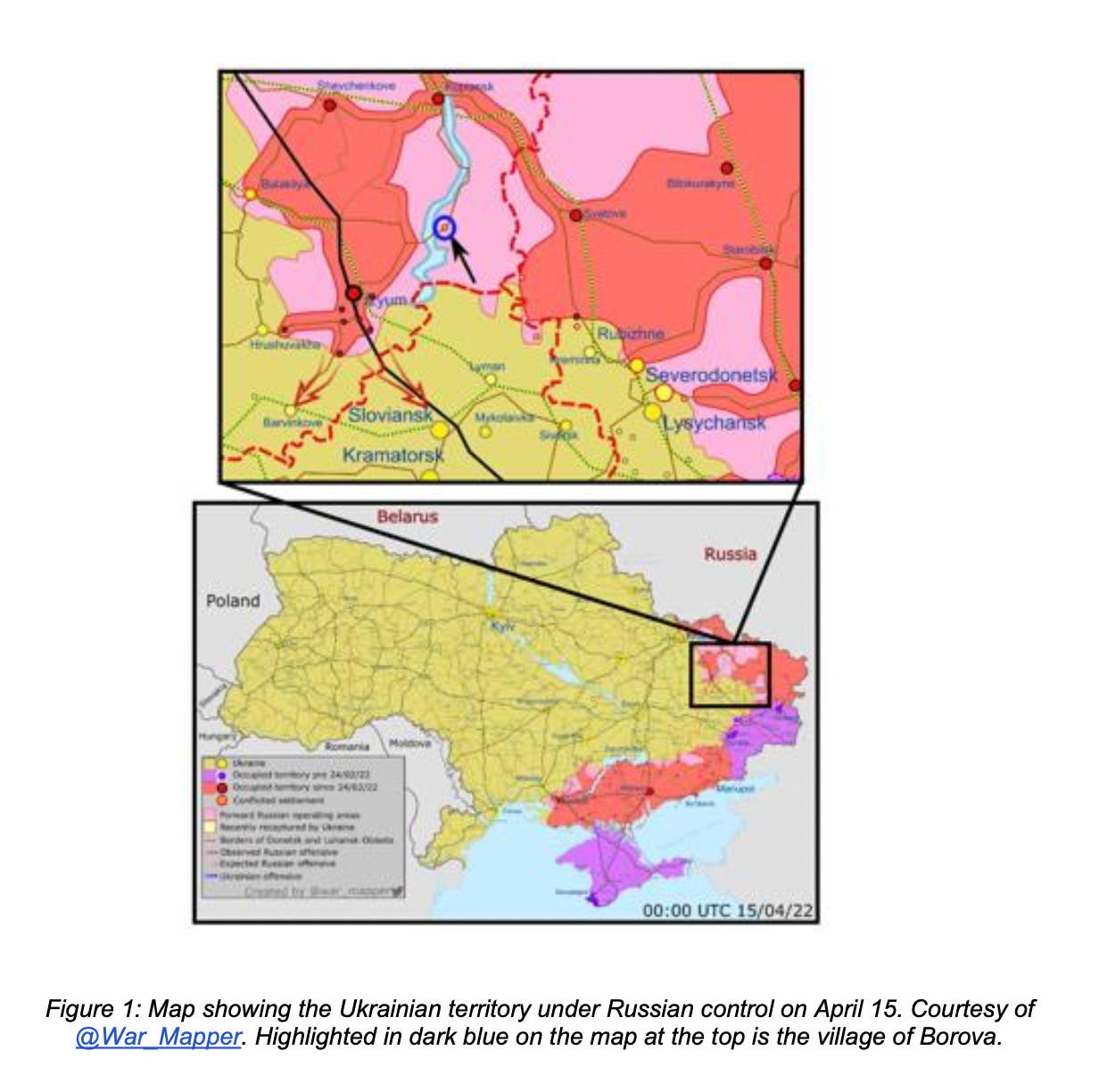
According to the Ukrainian Office of the Prosecutor General’s Facebook Page, an inquiry was opened to assess what happened on April 14 when Russian soldiers fired at evacuation buses carrying civilians out of controlled territory as these actions constitute a “violation of the laws and customs of war coupled with premeditated murder”.
A similar case occured on April 15 in the city of Starobilsk, Luhansk. According to a Facebook post by Lyudmyla Leontiyivna Denisova, the head of the Ukrainian Commission for Human Rights, the Russian military fired on Ukrainian buses attempting to evacuate residents from the city of Starobilsk, killing and injuring several civilians. Photos were shared online showing the evacuation buses, who were carrying civilians at the time, covered in bullet holes and with pools of blood on the bus floor.
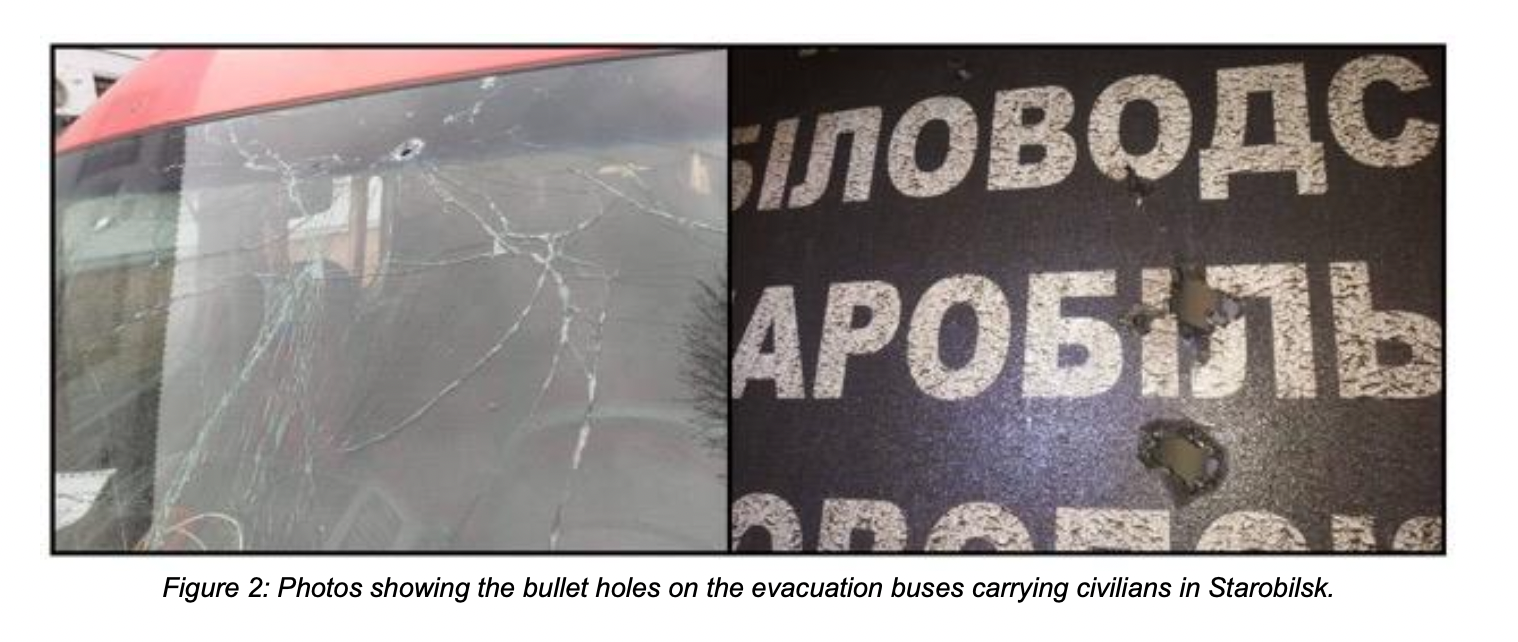
On April 29, whilst attempting to remove people from Popasna, Luhansk, two evacuation buses were shot at by Russian forces. According to Sergei Gaidai, the head of the Lugansk Regional State Administration, the Ukrainian military attempted to find the missing buses but only managed to find one of them. They had damage from grenade launchers, and no people inside, just blood. The second bus, which was carrying humanitarian aid and due to pick up civilians on the way back, was missing alongside the driver.
On May 1st, Sergei Gaidai shared an update on the situation on his Facebook Page claiming that the driver of the missing bus, Mikhail Pankov, had been found.
According to Mr Gaidai, the driver, who was a history school teacher volunteering to help take people to safety, had been taken into custody by the Russian forces. He was allegedly seen in a propaganda interview for нтв, a Russian TV channel, saying that the Ukrainian authorities were not helping their people evacuate. Sergei Gaidai claims that “Mikhail had no other option” referring to his need to participate in the video in order to survive at the hands of the enemy.
According to a BBC news article, during Mikhail Pankov’s interview for the нтв channel, the Russian journalist claimed that the driver had been found in Russia attempting to sell targets for Ukrainian artillery, and was a suspect of espionage.
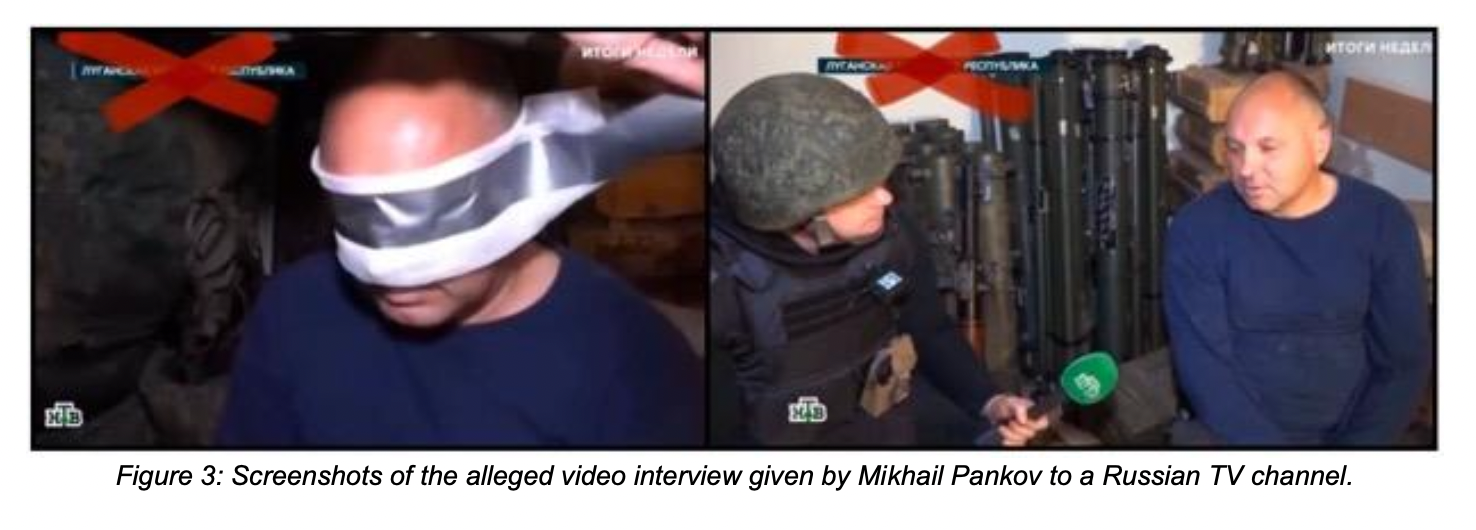
Mr Pankov’s family denies all Russian accusations, reiterating that he was only a history teacher who plays sports. During a BBC interview, Julia, his wife, confirmed that she had spoken to her husband and he was injured but alive. She also alluded to the option of being exchanged for captured Russian soldiers.
Previously on April 29, the BBC had also reported that Irina Vereshchuk claimed that the Russian government has been attempting to exchange Ukrainian civilians for Russian military prisoners in a move forbidden by the Geneva Convention.
According to her, “That’s why they captured all these hostages – civilians, women, employees of local councils, to try and use them“. Ms Vereshchuk added that, in their most recent instance of receiving nine civilians back, “there were badly injured people in this exchange – amputated limbs, sepsis, other severe injuries”.
Whilst humanitarian and Ukrainian evacuation buses in many Ukrainian cities were being targeted by the invading military forces, Russian controlled areas were also providing corridors for Ukrainians hoping to escape the war. These vehicles were, however, usually headed towards a filtration camp.
A video shared on Telegram on March 18 shows a group of people boarding buses near a gas station on the outskirts of Mariupol, Donetsk, under the watch of Russian soldiers. It is not clear from the video where the people were being driven to.
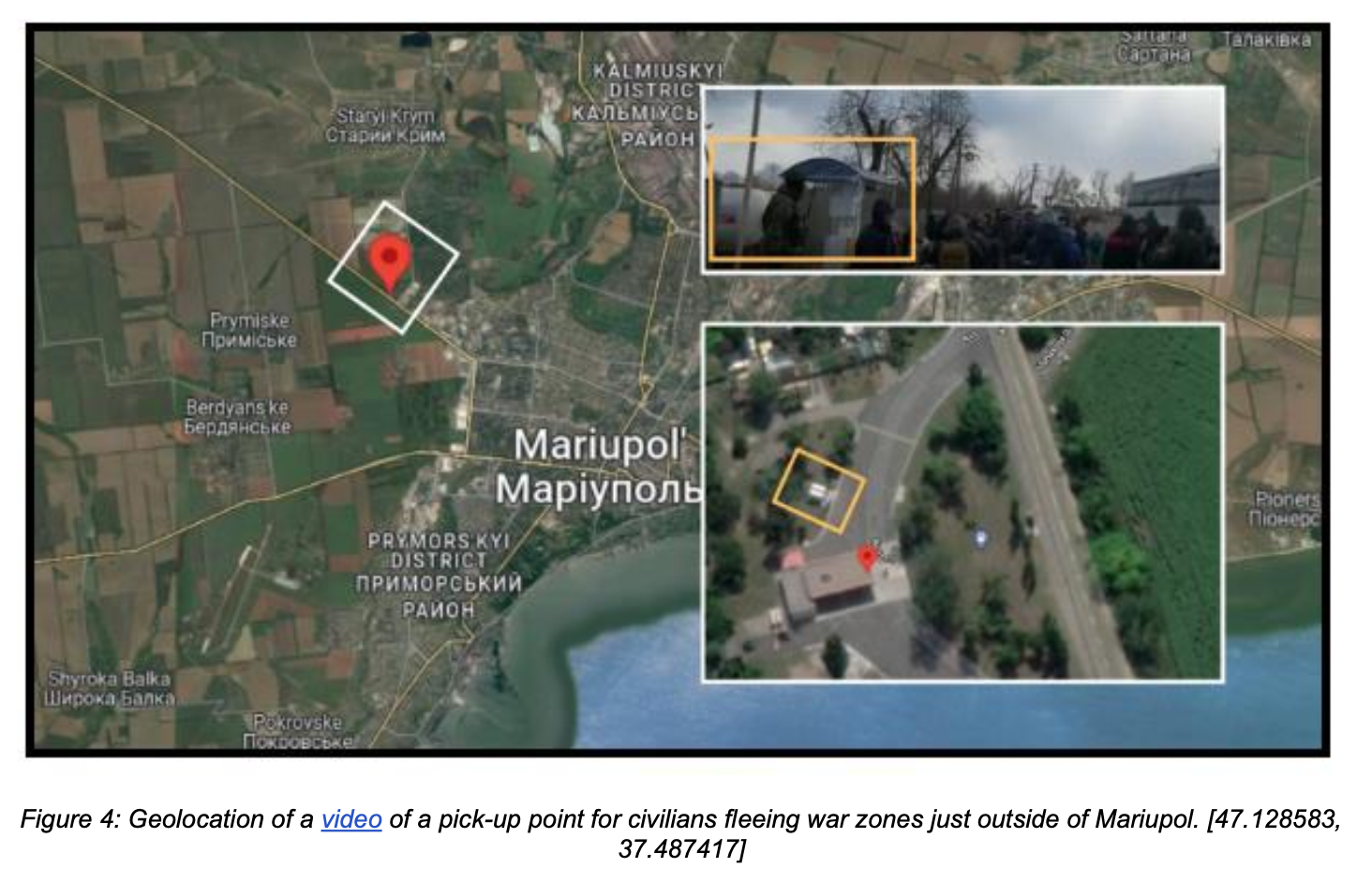
On April 20, a video was shared on Telegram showing Ukrainian civilians being evacuated from the district of Livoberezhnyi, in the Eastern area of Mariupol, Donetsk. They were under the watch of the heavily armed Russian military.
According to the Telegram post, “127 residents of the city of Mariupol were evacuated from the area of the Azovstal plant” on that day. The residents were heading to the village of Bezimenne, 20 Km East of their boarding point, towards the Russian border. There the Russian military had created a temporary settlement.
Below are some of the screenshots of the video which provide enough information to geolocate it to the outskirts of the district of Livoberezhnyi, Mariupol.
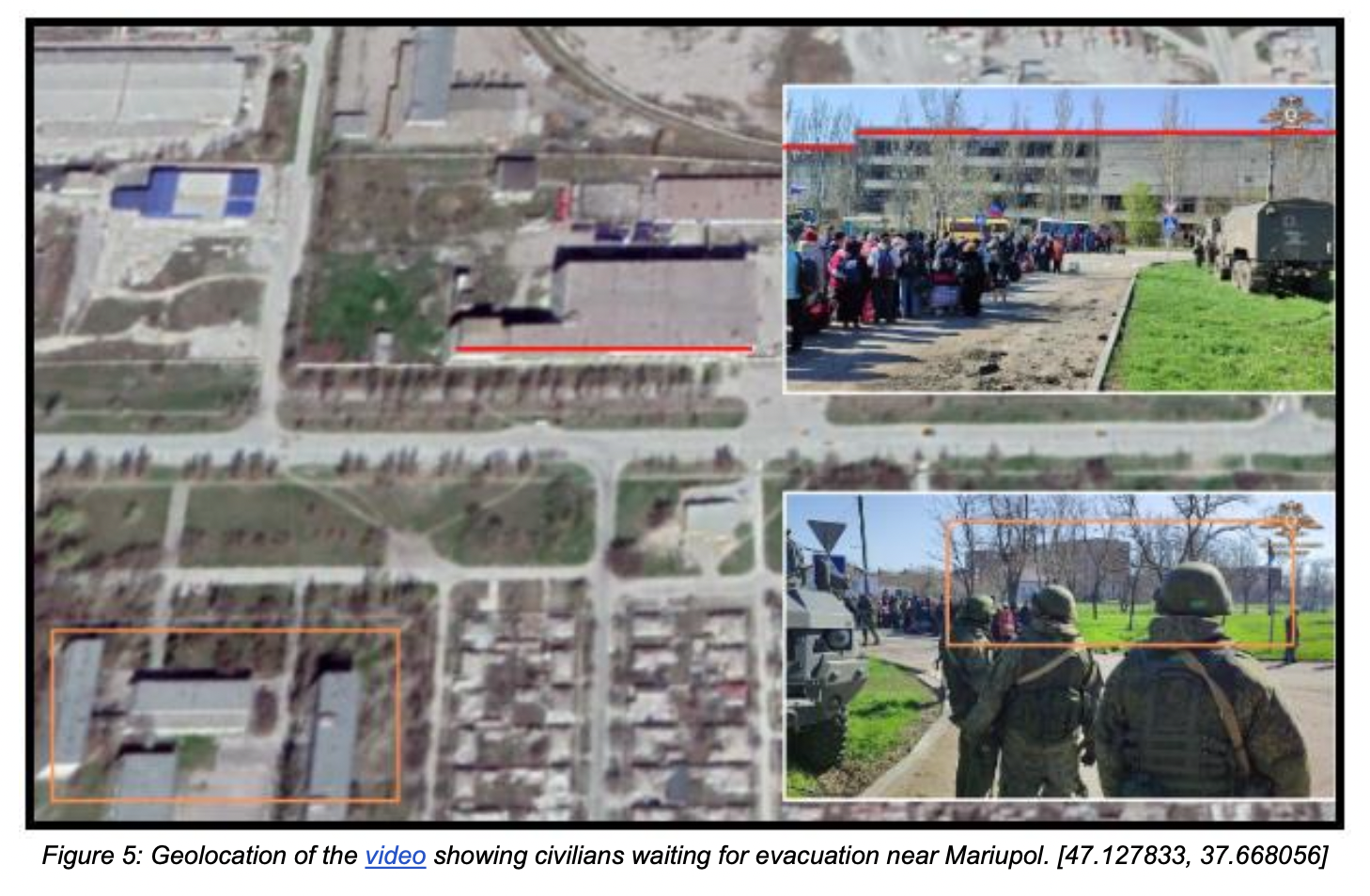
Russian Filtration Camps
On March 11, Оплот, a Russian state TV and radio broadcast, published a (since deleted) video showing several tents set up in the village of Bezimenne, about 20 km from Mariupol. The video is no longer available as the Russian TV channel YouTube account has since been terminated for “violating YouTube’s Community Guidelines”. Eyes on Russia was, however, able to geolocate several screenshots of the footage prior to its deletion to the centre of the village of Bezimenne.
The image below shows the location of the tent camp in the small village of Bezimenne, ready to receive the Ukrainian civilians.
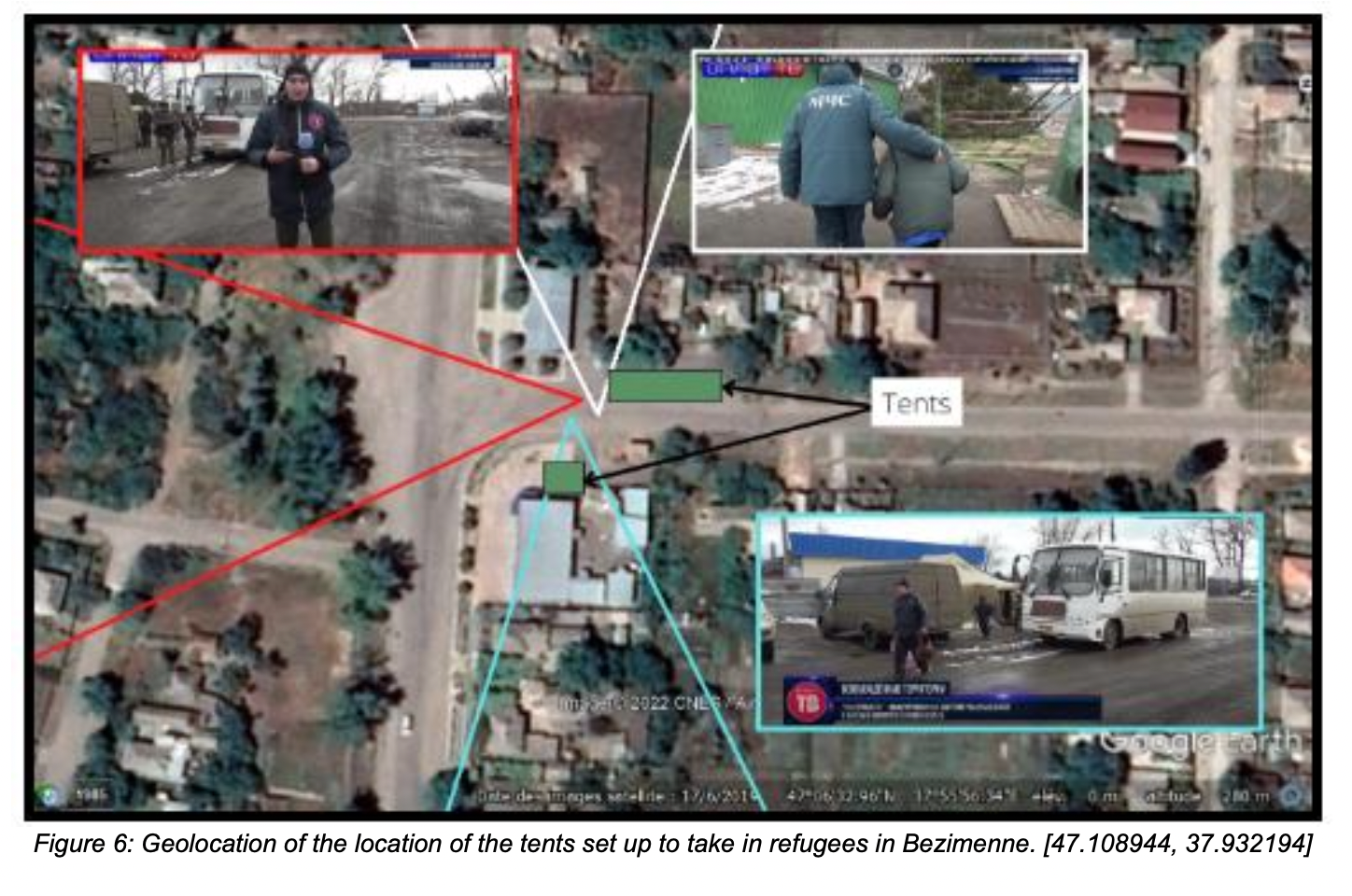
In the video it is possible to identify officials from the Ministry of Emergency Situations of the self-proclaimed Donetsk People’s Republic. They are alongside armed Russian military men wearing fatigues with a white armband; a distinctive sign of Russian armed forces. Also highlighted below is a vehicle with the colours and stripes of the Ministry of Emergency Situations, often seen near filtration camps.
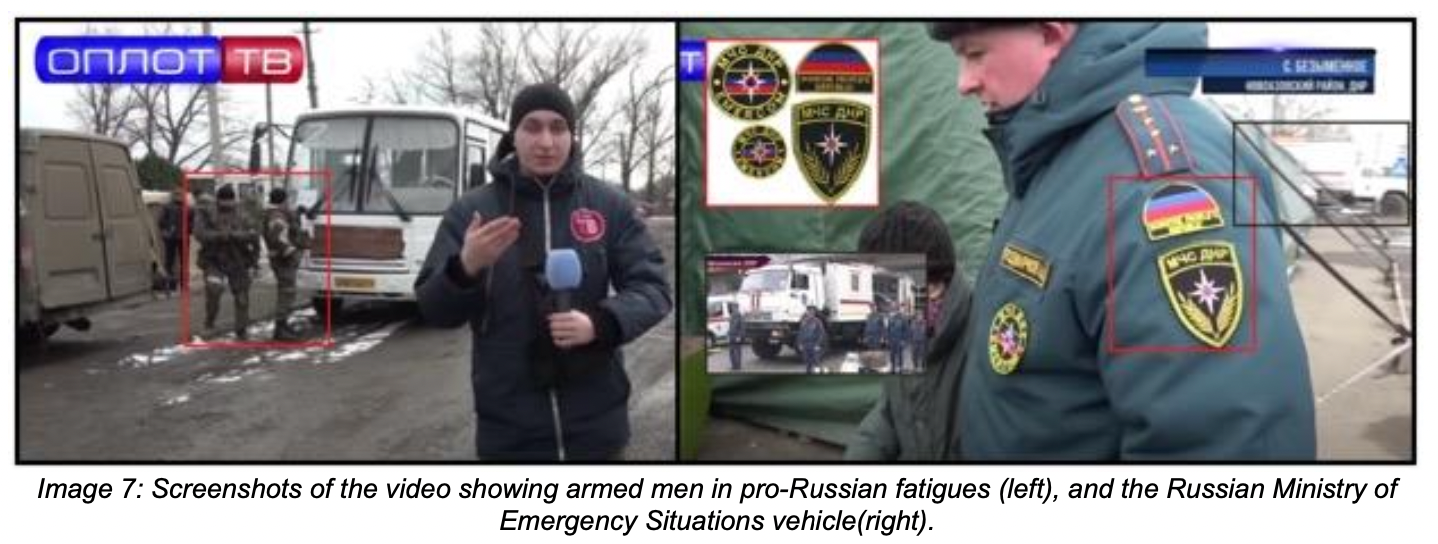
The same Russian state TV reporter also filmed the front of the local Bezimenne school where the civilians were allegedly being taken as part of the filtration process in order to assess if they are fit to be allowed to enter the Russian Federation.
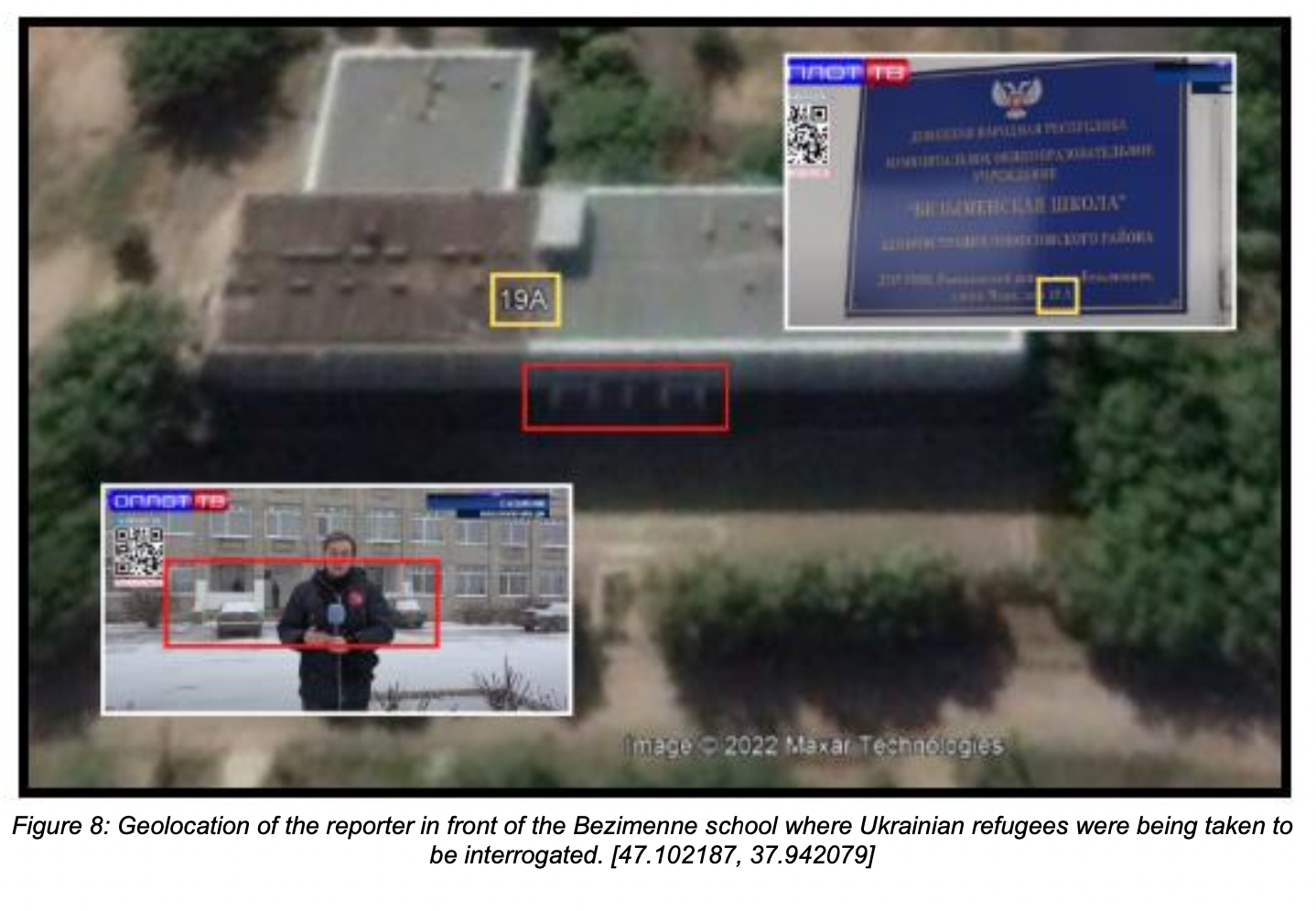
On March 22 the Russian Embassy in the USA shared a statement on their official Telegram Page claiming that the alleged “filtration camps” were in fact “checkpoints for civilians leaving the zone of active hostilities”. These served the purpose of avoiding “sabotage operations by the Ukrainian national battalions, servicemen of the RF Armed Forces by carefully inspecting vehicles heading to safe [Russian] regions.”
Depo Donbas, a Ukrainian news agency, published an article on March 28, detailing the establishment of a new camp in the village of Bezimenne. According to their report, 30 tents ready to accommodate up to 450 people were set up in this small village in Donetsk.
Taganrog Pravda, a Russian media channel, shared on YouTube a video on March 22 of the tents at the Bezimenne camp where vehicles of the Russian Ministry of Emergency Situations can be seen in the background. Highlighted in pink below, in front of the red roofed building.
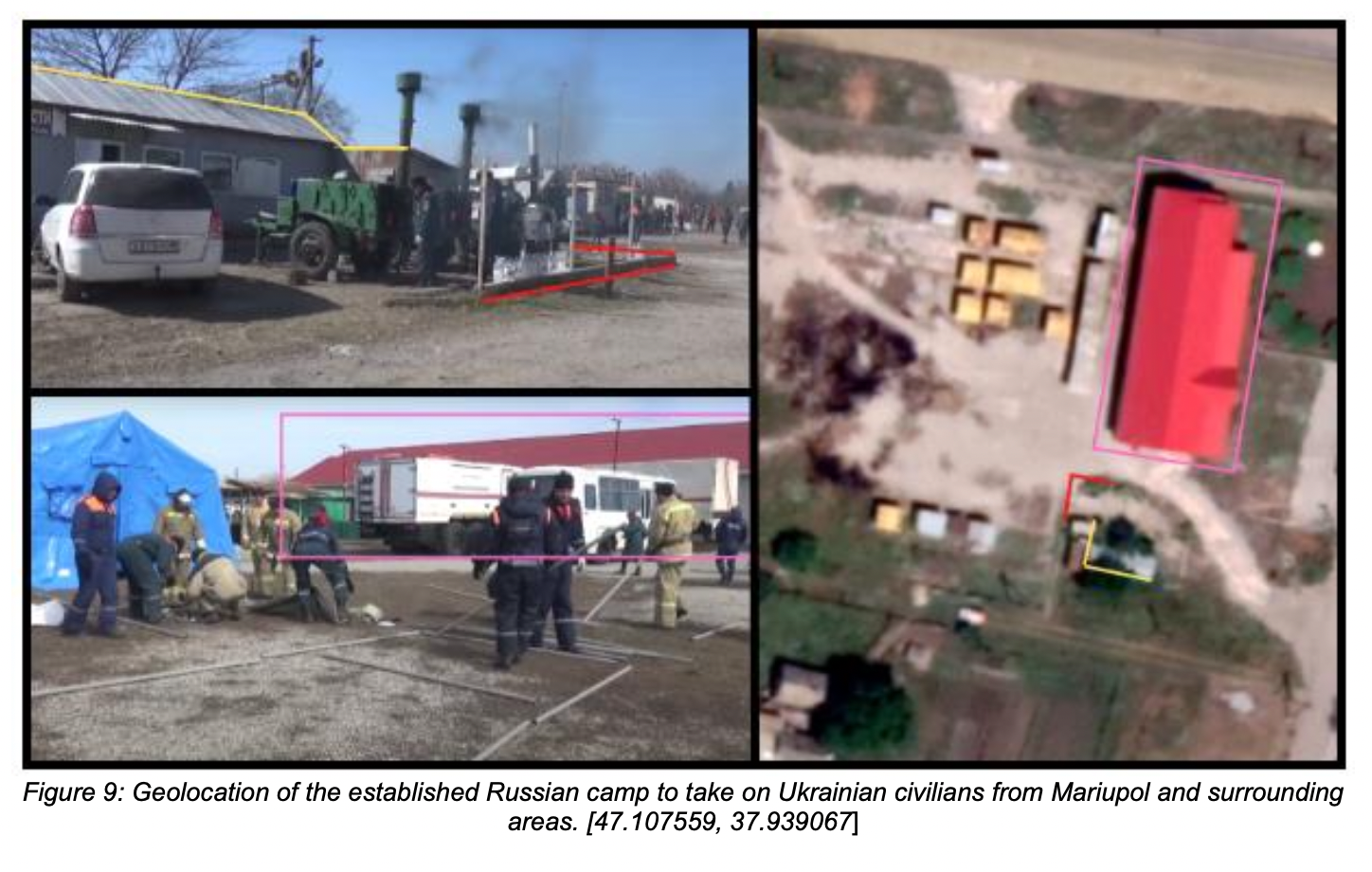
On May 2, a pro-Russian YouTube channel published drone footage of the Bezimenne filtration camp. The video shows a queue of about 500 metres of military vehicles, evacuation buses, and ambulances parked on the main road of this small village, East of Mariupol. According to the caption of the video the buses were being used to transport refugees from Azovstal to the Bezimenne filtration camp.
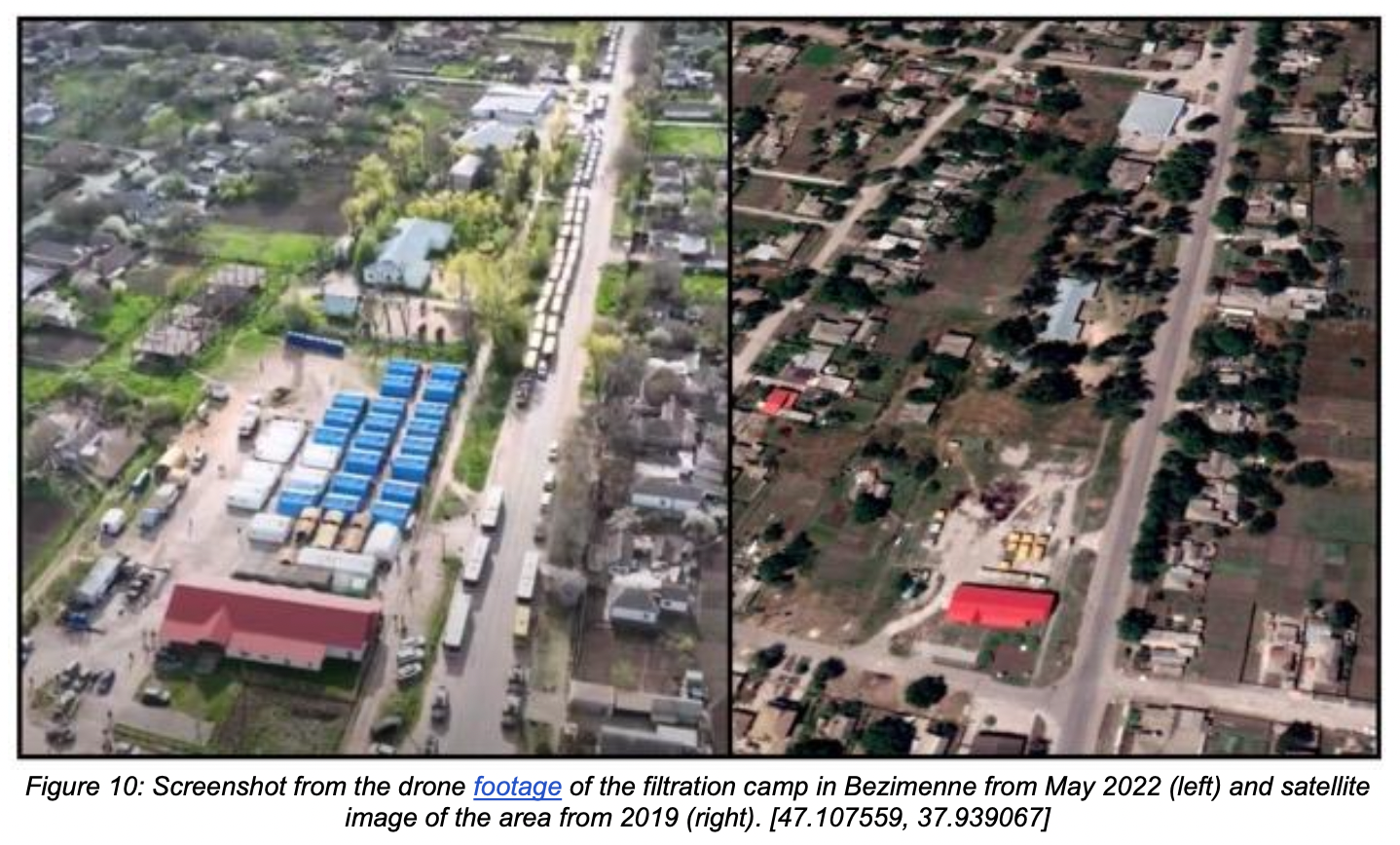
On May 5, a video was published on Telegram showing several evacuation buses arriving with civilians at the Bezimenne camp in Donetsk. According to the Telegram post, the refugees were coming from the Azovstal plant in Mariupol, which had suffered an assault by the Russian forces the previous day. They were placed in the tent camp in the village of Bezimenne.
The video shows a heavily armed group of Russian military forces waiting and escorting the refugees towards the camp, as seen by the images below.
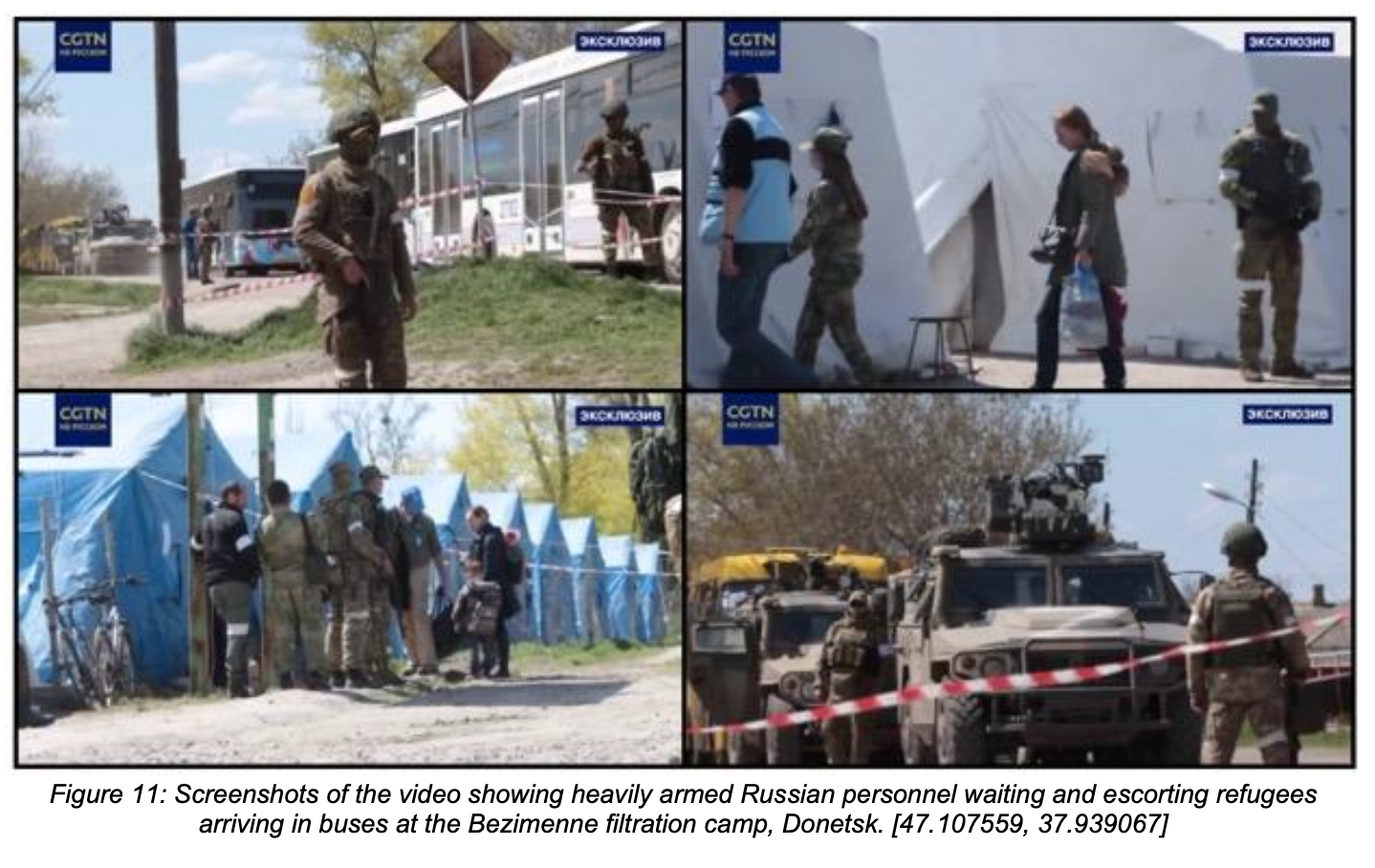
On May 24, a Telegram account shared the complete list of the 11 filtration camps in Donetsk. These tented camps have, allegedly, been receiving civilians for the past several months from the various Mariupol districts.
A heavily armed Russian military presence has been previously documented at the geolocated Bezimenne camp.
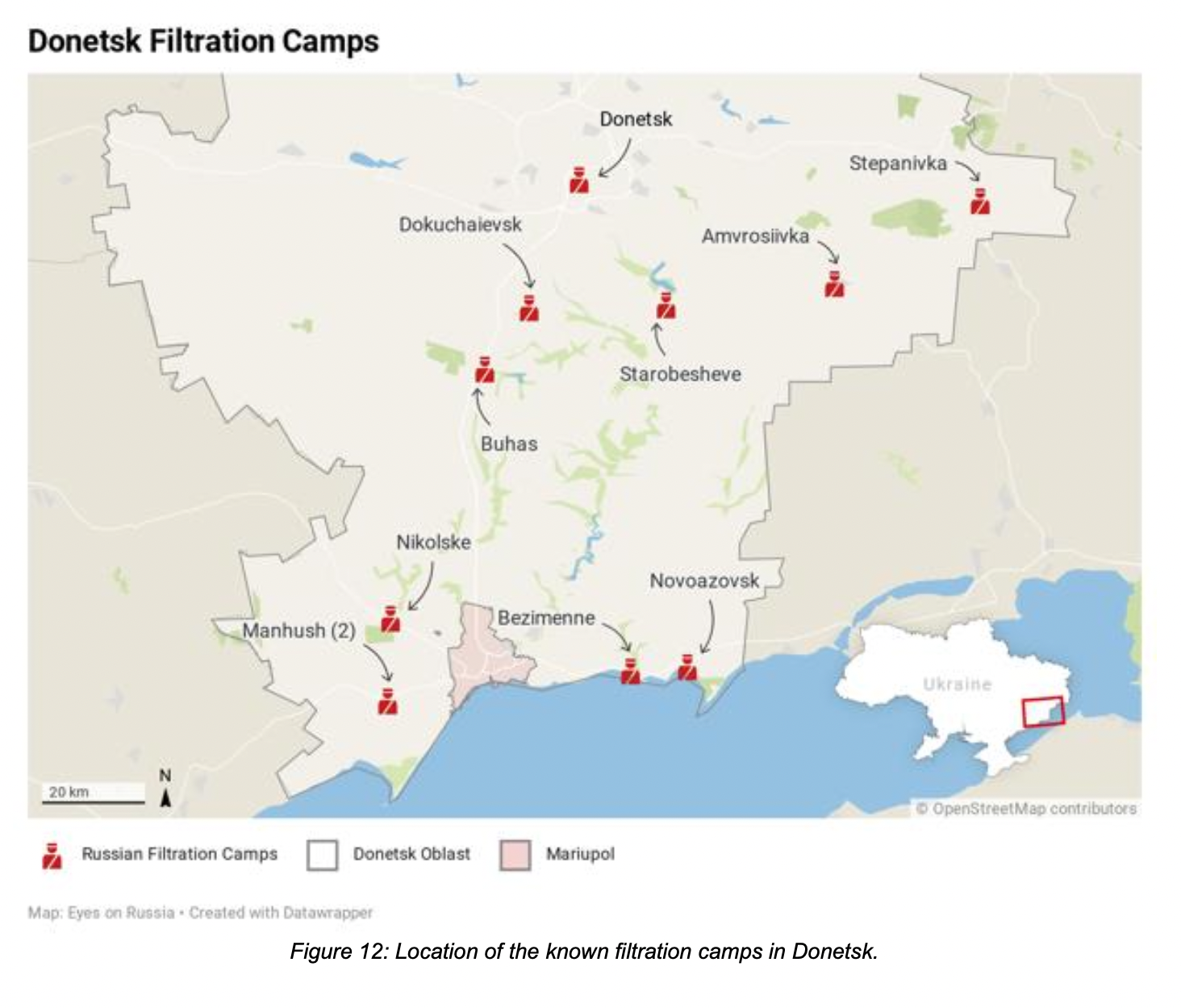
Despite the early reassurance of the Russian Embassy in the US regarding the “real purpose” of the filtration camps, harrowing accounts of civilians that have experienced them and chose to share their stories, have emerged in the past months.
In an article published on April 29, Maria Vdovychenko, a 17 year old from Mariupol, recounted her experiences with the filtration process. The young girl explained how the filtration location she went through, in the small village of Manhush, was not a settlement but a room where people would go after waiting for their turn in the queue. This could sometimes last for days.
She recalls a conversation between Russian soldiers that she overheard just before her turn in the room where one of the soldiers asked “What did you do with people who didn’t pass the filtration?”. According to Maria, a different Russian soldier claimed to have shot 10 people before he stopped counting due to “lack of interest”.
The 17 year old also recalls how her legs were trembling as she was forced to be alone in a room with five male Russian soldiers and one, who was lying on a mattress, said: “Don’t like it? There will be more women ahead. We’ll find something”, whilst alluding to the possibility of one of the soldiers raping the young girl.
In an interview to CNN on May 23, Maria also told the reporters how, during her father’s interrogation, the Russian soldiers threatened to cut off his ear. He had received so many blows to his head, that “several medical examinations have now confirmed his sight has been permanently damaged”.
On May 5, a Telegram channel shared an indoor video of the situation in the filtration camp at the Bezimenne school. The footage, recorded using a hidden camera, provides evidence to the conditions experienced by the illegally detained civilians. More details provided on the following Telegram post regarding this situation mention how the Russian military forcibly removed all men from several districts in Mariupol and placed them at the local school in the small village of Bezimenne for “filtering” purposes. This is where the men have since been incarcerated for weeks.
The person in the video describes the conditions in which they live as “unsanitary”, as “people are forced to sleep on the floor in the corridors”, and “medical assistance is not provided”. He claims that there is only one wash basin for over 350 people, and one toilet outdoors which, according to him, is impossible to enter due to the smell. A case of tuberculosis was allegedly recorded at the school which led to a large number of people being kept in isolation and “locked up without medical care”.
Below are a few screenshots of the hidden video at the Bezimenne filtration camp, where hundreds of men are kept against their will.
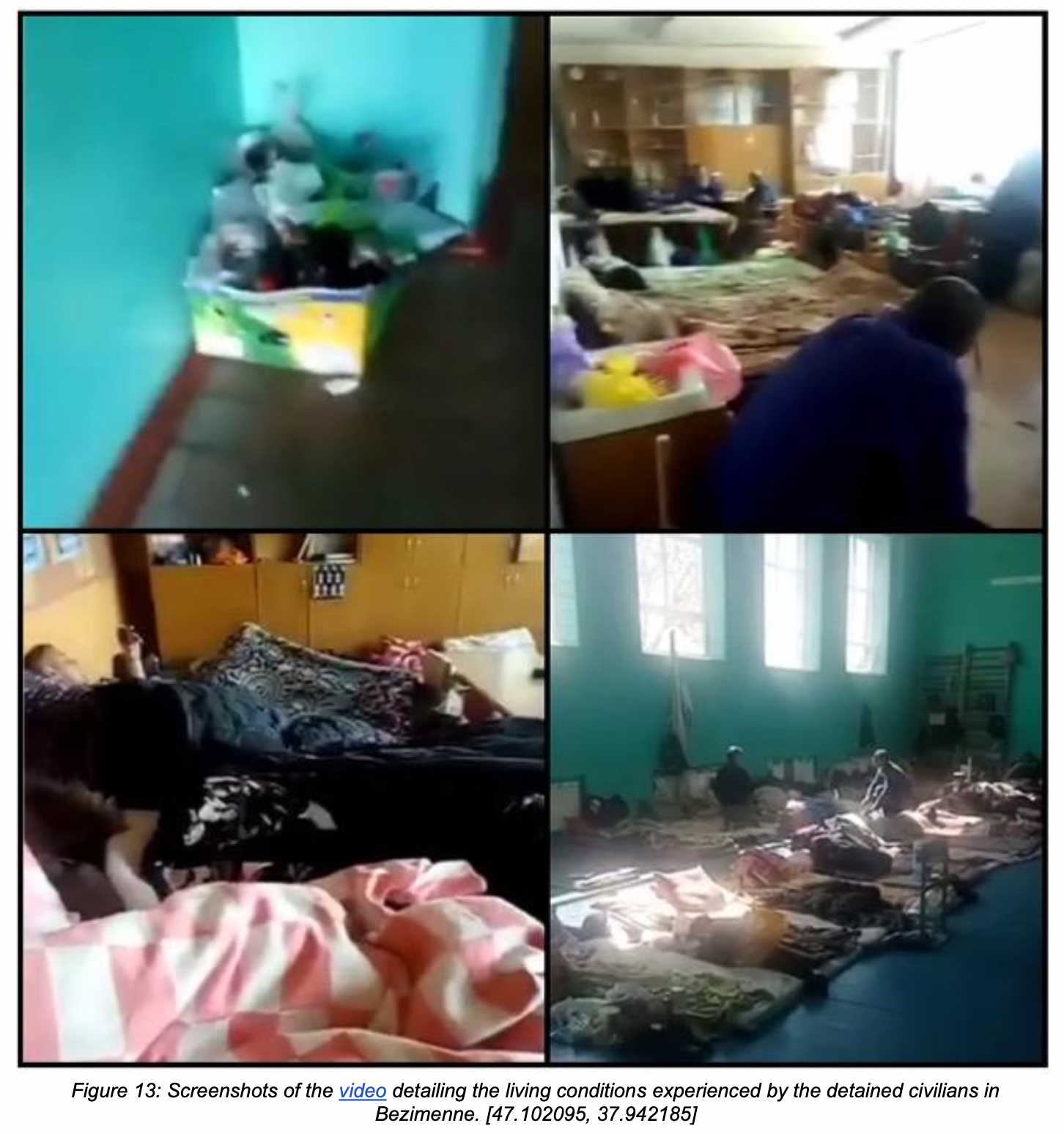
In an attempt to explain why, after weeks of detention, the men are not allowed to leave the building despite having “passed filtration”, the person claims that he heard the Russian men saying that they have not yet decided whether they want to use the captives as “labour for the demolition of the Mariupol rubble” or to mobilise them for the Russian army.
This footage, recorded by one of the men detained at the building, was geolocated to the same school in Bezimenne where the Russian state TV reporter was filming a story on refugees on March 11, also previously geolocated.
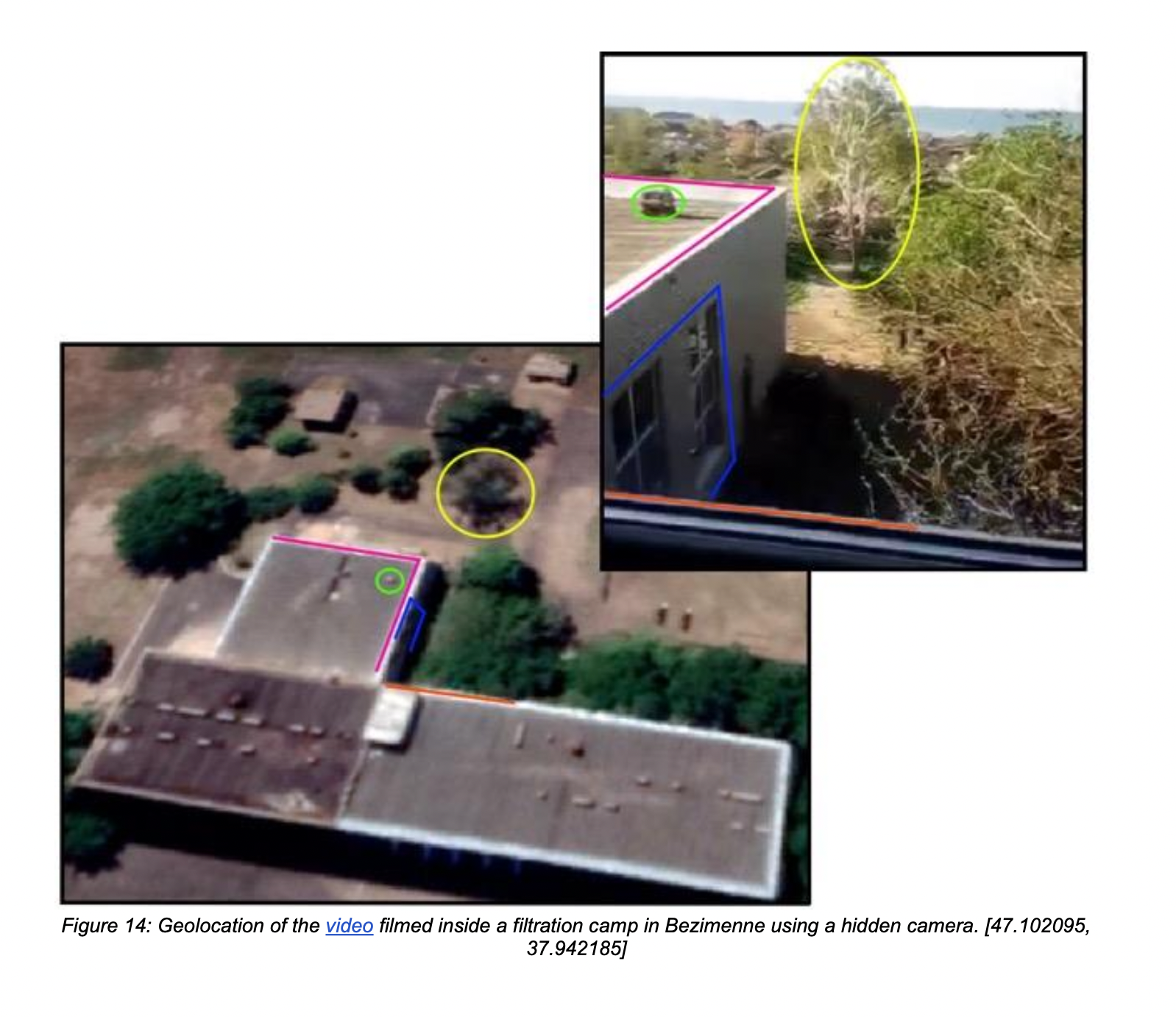
On May 26, Politico published an article detailing the experiences of a group of women who had been forcefully deported and processed through filtration camps, before being sent to Russia.
According to their story, the women, who hid in a shelter in Mariupol for 20 days, were forced to board buses by Russian soldiers on March 15 after being found. They recalled how a woman, after being taken outside for the first time since the war started, and witnessing the obliteration of Mariupol, suffered a heart attack and died as a result of the denial of medical care by the Russian soldiers.
The buses, which only took women and children, stopped at the village of Bezimenne where Russian troops, emergency workers, and agents of the Russian Federal Security Service were waiting for them. This claim has been corroborated with footage previously analysed and geolocated by EoR.
One of the Ukrainian women, Oksana, describes how she was photographed from various angles, had her palms and fingers printed, and forced to provide her home address and passport information. A similar recount of the initial process was told by Anna, a Mariupol refugee interviewed by CNN, in an article published on April 7.
In addition to collecting this information, Oksana also reports having her phone taken and all her contacts and data downloaded to a computer in order for the Russian interrogators to check if she had any connections to the Ukrainian government or military personnel.
The Russian military allegedly questioned everyone, even children, in an attempt to get them to say something incriminatory. Oksana recalls how at the end they were exhausted as each interrogation lasted between 30 minutes to an hour, persisting until the next morning. Additionally, she claims that some people provided answers that the Russian men did not like and those were then taken away and were not seen again.
Once the interrogators were satisfied, the group of women were sent to a temporary accommodation camp in the city of Vladimir, Russia, over 1000 Km North of their home in Mariupol. Upon arrival they were met with a crowd of Russian state media eager to portray their own government as benevolent towards the Ukrainian refugees. Oksana claims that the local authorities were distributing 10,000 rubles (around £144) per family and telling them they “should be grateful for the assistance”.
According to her recollection of the events, once in Russia, they went through four additional interrogations focusing on their feelings towards the Ukrainian military. Oksana was pressured into enrolling her children in the local school which, according to her eldest daughter, included “revisionist history lessons about how Ukraine wasn’t a real country but something that was created by Russia, and thus something that could – and should – be taken away.”
Oksana and her family managed to eventually flee Russia at the end of April.
Temporary Accommodation Centres
On March 12 the Russian government issued a Decree detailing the distribution of forced displaced persons arriving to the territory of the Russian Federation, coming from both the Donetsk People’s Republic and Luhansk People’s Republic. According to the document, later amended on April 18, the evacuees were to be sent to Temporary Accommodation Centres throughout the country, with the exception of Moscow City and St Petersburg in Russia, and Sevastopol in Crimea.
Below is a map visualisation of the amount of people that each constituent entity was expected to receive. Voronezh Oblast was set to accept 7000 refugees, the highest number of any Russian region, followed by Krasnodar Oblast accepting 5330, and Rostov Oblast with capacity to take on 4725 forced displaced people.
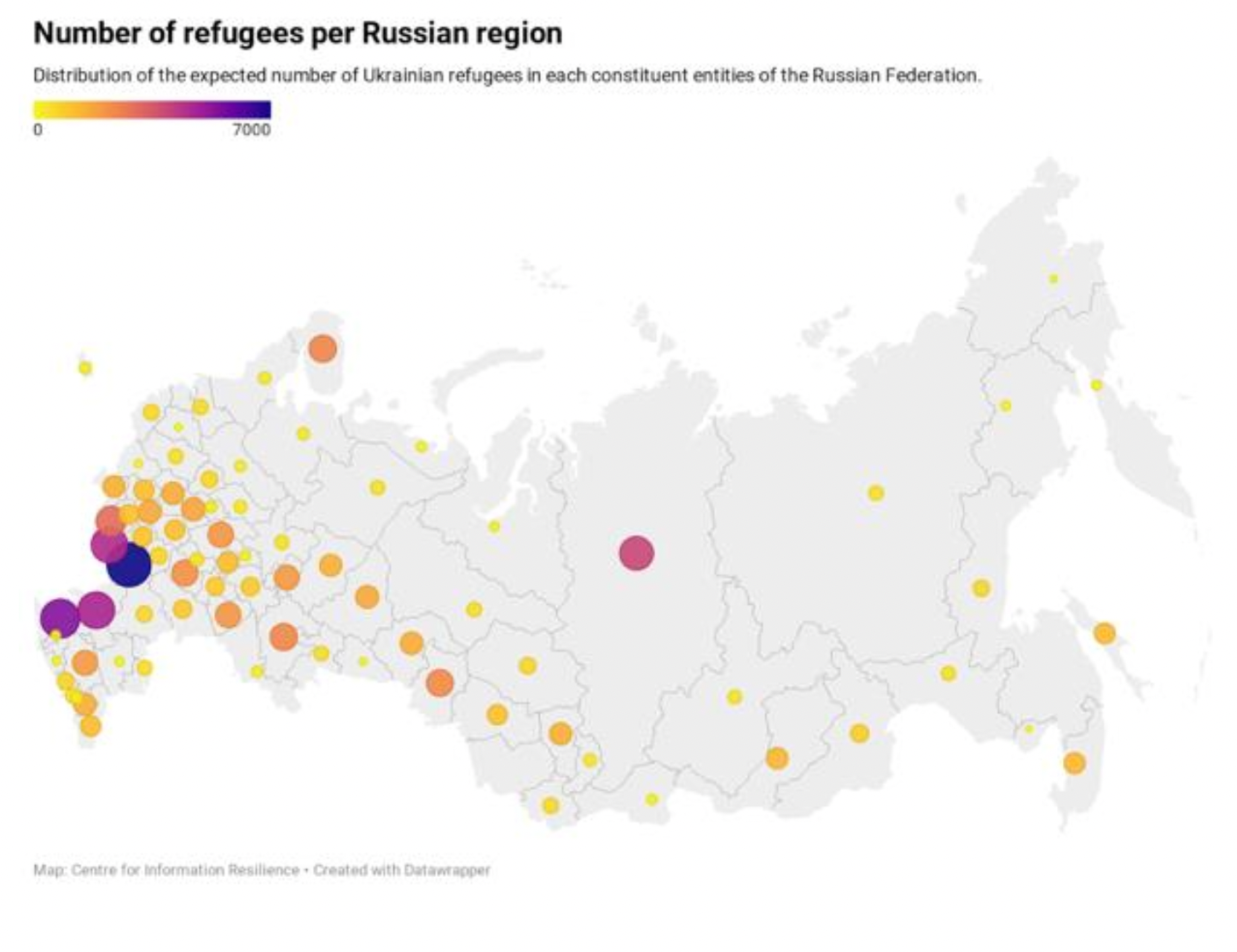
The story of Oksana and her family is similar to many others. Just twenty-five kilometres from the village of Bezimenne, several tents were set up on the Russian side of the border to facilitate the deportation of Ukrainian civilians into the Russian Federation.
On March 19, Taganrog Pravda, a Russian media outlet, published a video showing buses coming across the Ukrainian-Russian border transporting civilians to the checkpoint camp with tents set up in the Russian territory.
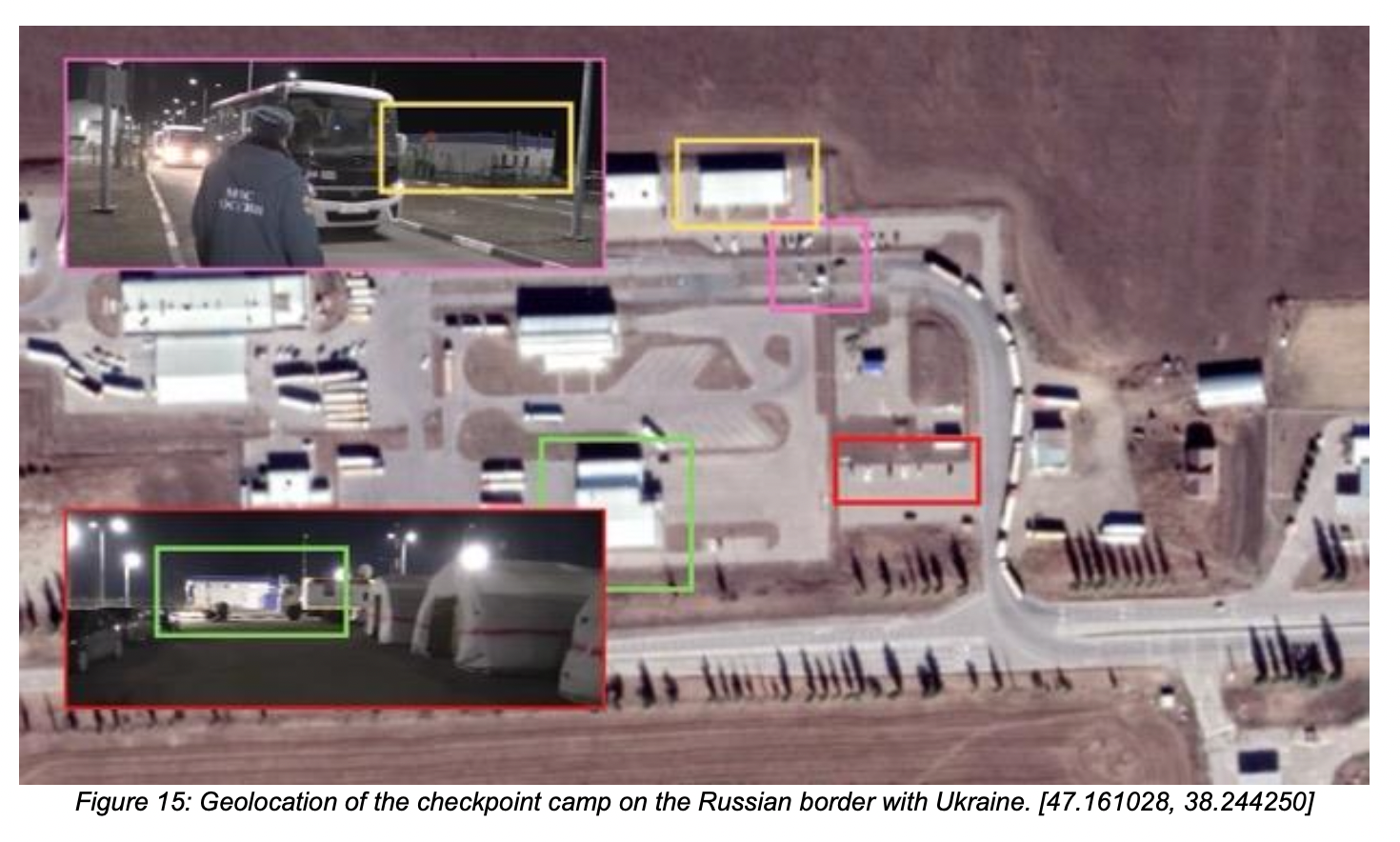
In the video, the civilians in the bus explain that they are from Mariupol. Next, men from the Russian Ministry of Emergency Situations inform that they will be taken to the city of Taganrog, in Rostov Oblast, Russia, located 50 Kilometres from the border. Here, several Temporary Accommodation Centres were prepared to receive them.
According to an article from a local newspaper, published on March 17, more than 500 refugees were already in Taganrog, in one of three Temporary Accommodation Centres. On March 16, Inna Titarenko, the head of Taganrog, visited one of the centres where around 200 people were staying. A third of these were children from 3 to 10 years old.
A photo (left) taken at the centre allowed Eyes on Russia investigators to geolocate the scene to Dvorets Sports Complex, in Taganro. This was done by comparing it with a photo from a fencing competition taken in 2019 (right).
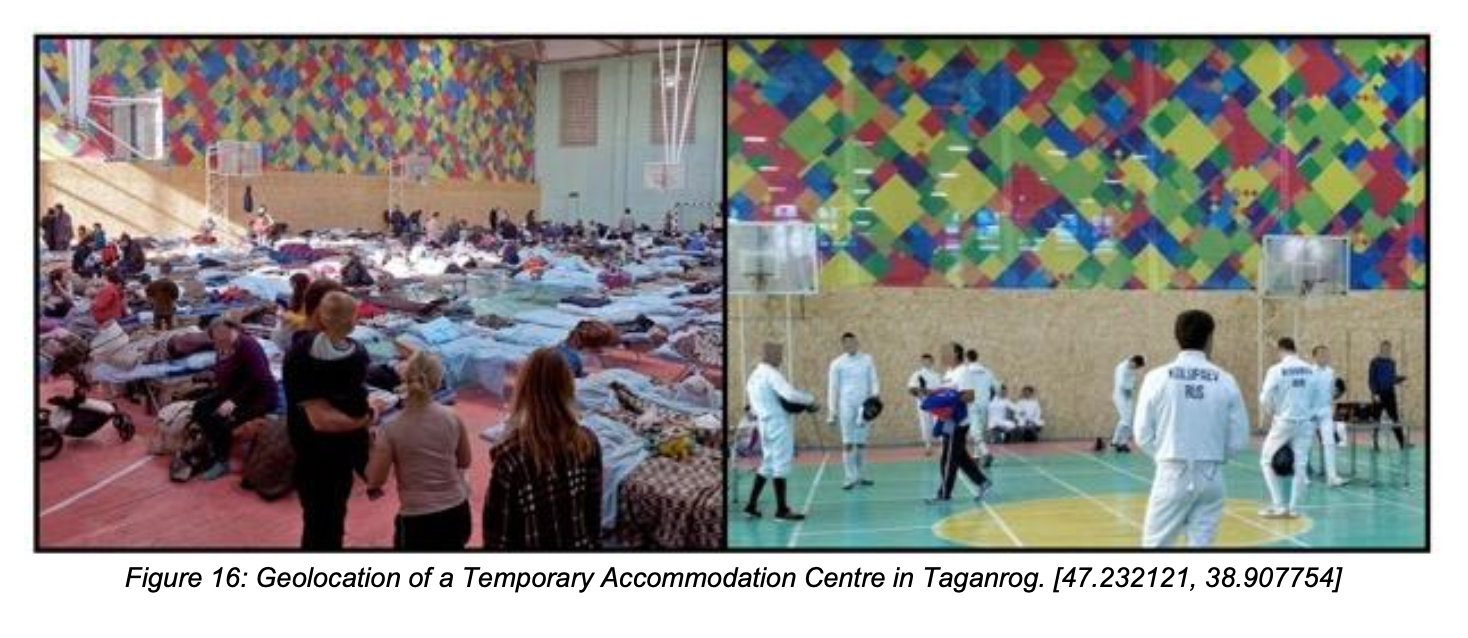
On March 23, a UN delegation headed by Karim Atassi, the UN High Commissioner for Refugees in the Russian Federation, visited the Temporary Accommodation Centre alongside a high number of reporters covering the event.
Mr Atassi is seen below, on the left photo, talking to a young refugee child, in the same place where a photo of the stadium was taken in 2021 (right), thus indicating that this was also at the Dvorets Sports Complex, previously visited by the head of Taganrog, a week earlier.
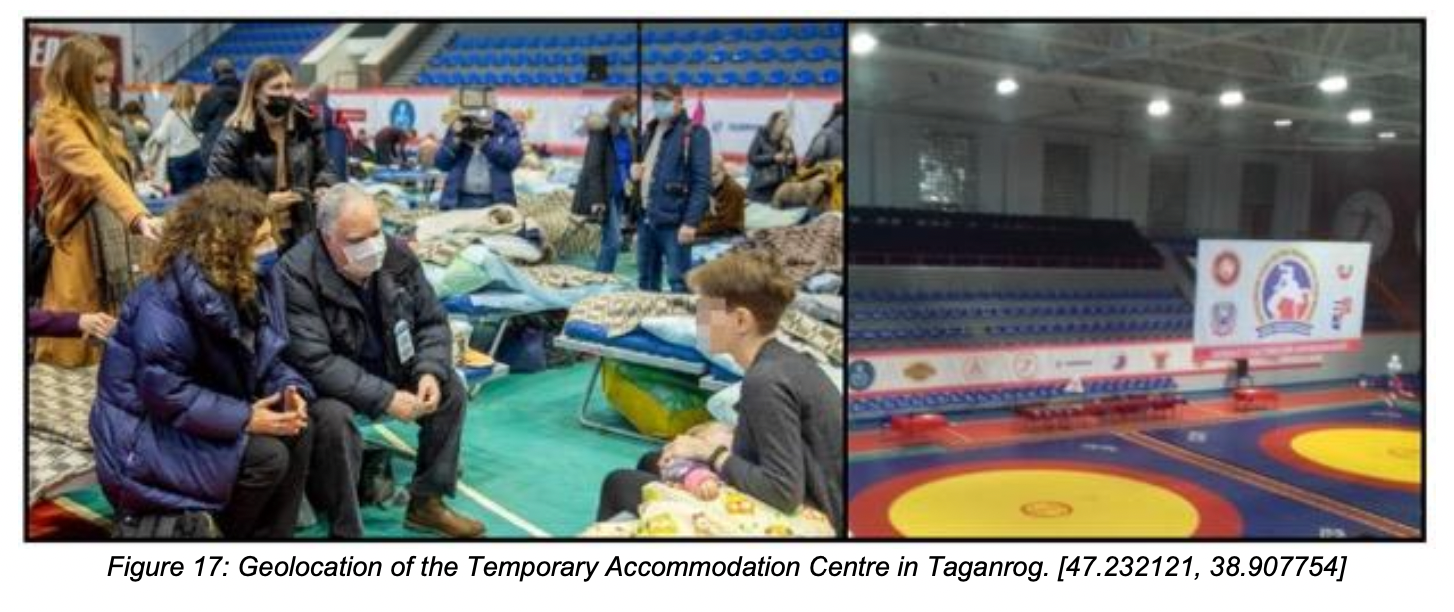
Promises versus Reality
Natalia Nekhlebova, a Russian journalist, interviewed Angela. She had been taken from Donetsk by the Russian military when she was eight months pregnant. According to Natalia’s article, published on June 20, Angela was put on a train with her husband and 3 year old daughter with the impression she was going to Vladivostok, a city in the Far East of Russia.
Vladivostok was described to them as “a big coastal city, like Mariupol”, with the sea, and a climate similar to what they were used to. They were told salaries were high and they would be given housing and land almost free of change.
The reality was very different; as they soon realised they were on their way to Wrangel, a small town 200 Km from Vladivostok. Her husband was not able to find a job that paid enough to afford rent. As of June, Angela has escaped Russia with her daughter but her husband had to be left behind.
Natalia writes how at the previously geolocated Taganrog Sports Complex, hundreds of people waited for their turn to travel, whilst brochures were distributed to the refugees with many promises and enticing offers.
Below is a photo of one of them.
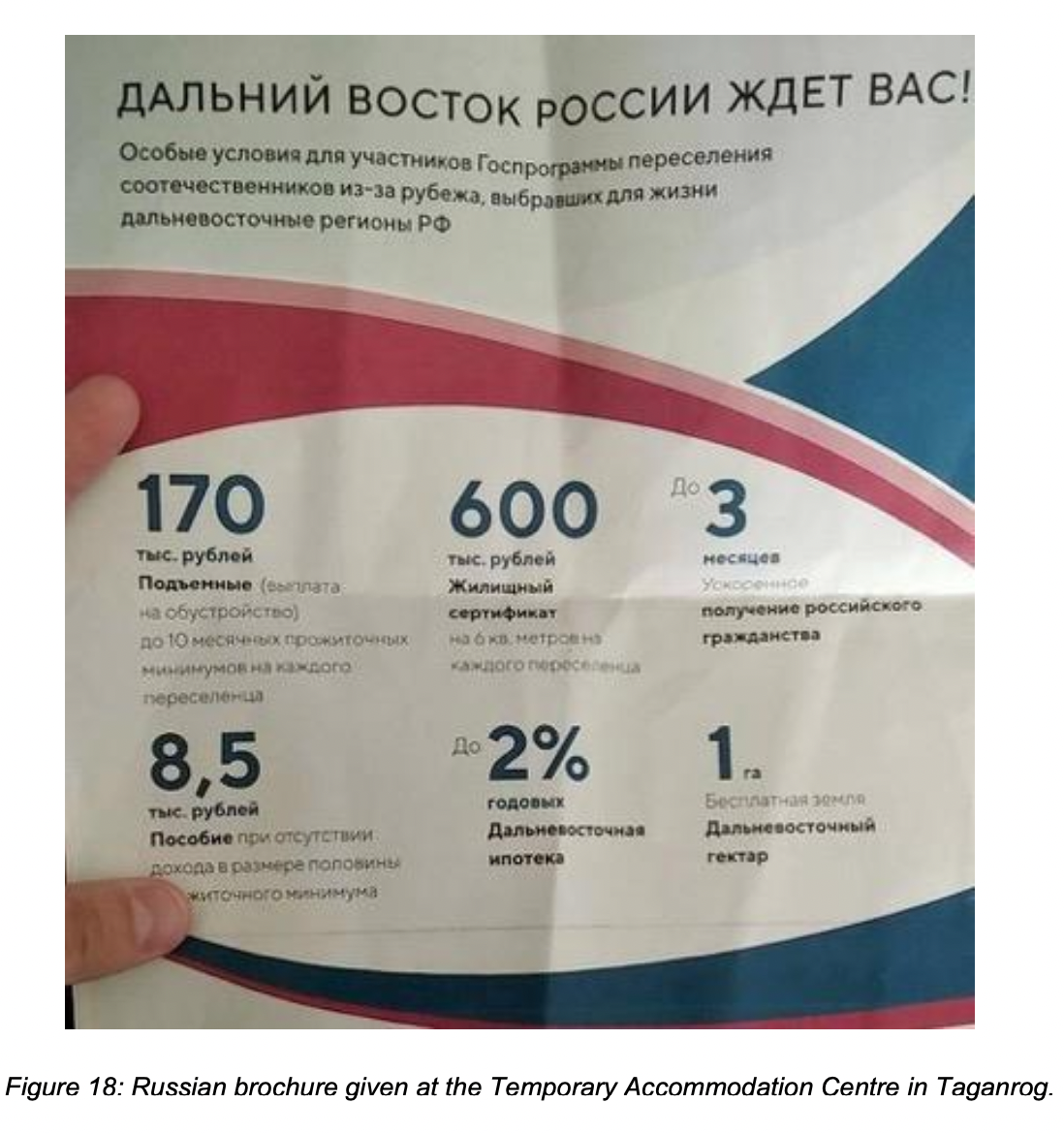
The pamphlet, which starts with “The Far East of Russia is waiting for you! Special conditions for participants in the State program for the resettlement of compatriots from abroad who have chosen the Far Eastern regions of the Russian Federation for life”, goes on to list the many benefits of choosing the Far East of Russia.
170,000 rubles for settling (payment for the arrangement);
600,000 rubles housing certificate for 6 square metres for each migrant;
Up to 3 months – accelerated acquisition of Russian citizenship;
8,500 rubles – allowance in the absence of income in half of the subsistence level;
Up to 2% per annum – Far Eastern mortgage;
1 hectare is free land, a Far Eastern hectare.
Elena, a volunteer working with Ukrainian refugees in Primorye, a Russian region on the Far East of Russia bordering China and North Korea, tells the reporter how most of the promises were either untrue or had several conditions that the people were not informed about before being almost seven thousand kilometres away from their homeland. She claims that the mortgage at 2% only applies for young families or those who plan on building a house in the Russian Far East.
Once there, they would either need to cut down forest trees or drain swamps, in land often 120 Km away from civilization. Refugees, like Angela’s husband, were only offered low paid jobs with salaries of 35,000 rubles when rent costs 30,000 rubles.
Denis, a Ukrainian refugee who, alongside his wife and young son, was also unknowingly sent to Wrangel. There he attended a meeting at their Temporary Accommodation Centre in Primorye where the governor, Oleg Kozhemyako, explained how the resettlement actually works.
According to Denis, Mr Kozhemayko told them that the housing certificate was only available after three years and not immediately as they were originally informed, and only if you obtain Russian citizenship. The 170,000 rubles for settling on the brochure would also not be available until six months later where they would only receive half the promised amount.
Regarding the “1 hectare of free Far Eastern land” it would only be given within five years and it would be, as Elena had mentioned, in the forest. In addition to all these extra clauses, if the refugees chose to join the program, they would have to stay in their place of registration for three years to be eligible for any of the items on the list.
As of June, Denis and his family have left Wrangel and live in a city near St. Petersburg whilst continuing his attempts to escape Russia.
According to Svetlana Gannushkina, a Russian Human Rights activist, in an interview to Lenta, a Russian news agency on June 27, local employers are very reluctant to hire the refugees as it is a “hassle” to handle all the bureaucracy.
Oleg Risota, a Russian farm and business owner from Moscow Oblast, explains his predicament when attempting to hire refugees in an interview published on June 2, by Business FM, a local Russian radio and news agency from Moscow.
According to Mr Risota, it is not possible to officially hire Ukrainian citizens as, in order to do so, they first need to either get a licence or refugee status. This is a long and tiring process that is “unrealistic” for the majority of people who arrive without documents.
Mr Risota explains that he is yet to meet a single person that has obtained the refugee status, despite the fact that many farmers like himself want to hire these Ukrainian citizens to help in their fieldwork. His first mention of the situation was on February 26, when he wrote on a Twitter thread “Without refugee status or a licence, there is no chance of them being officially employed. And hardworking people do not want to sit idly by, but want to work and provide for themselves.”
In the past months Oleg has reportedly, alongside with other farmers, appealed to the Russian authorities regarding this situation. He was told that “everything is fine, there are no problems”, and, as of June 2, date of the published interview, nothing had yet been done.
Conclusion
The Russian government has made it very difficult for Ukrainian civilians to safely leave war zones – either by blocking humanitarian corridors or by targeting Ukrainian vehicles. With the only choice being between a Russian evacuation bus or facing Russian artillery, many people are forced to board buses headed to filtration camps.
When in Russian custody many refugees report going through intense interrogation, often with verbal abuse, threats, or actual physical assault. According to reports some people were simply never seen again.
Evidence in the form of hidden footage was found showing Ukrainian men being kept against their will despite having passed filtration. The men were living in unsanitary conditions with no medical assistance in a building in Bezimenne, a Russian controlled village East of Mariupol.
For the people that passed their filtration process and were allowed to leave, the Russian forces loaded them into buses to be taken to Temporary Accommodation Centres already in Russian territory. Once across the border they are given promises regarding access to work, housing, and financial assistance.
Many refugees boarded buses and trains taking them to cities over 7000 km from their homeland where they quickly learned that almost all assurances made to them by the Russian government were either untrue or came with unattainable stipulations. Several reports and interviews were found of Ukrainians that have managed to escape once out of the attentive watch of the Russian forces, but those are a minority.
Official data points to almost 1.5 million refugees having crossed the Russian border in the past months, many of which likely against their will. Trapped in a system that forces them towards Russia whilst presenting the illusion of choice, most will not have the money, connections, or even the mobility to attempt an escape.
Unable to find work, pay rent or save enough for the transport back to Europe, hundreds of thousands of Ukrainian citizens find themselves in a precarious situation in a country that claims that their homeland was “created by Russia, and thus something that could – and should – be taken away“.
Download a PDF of this report below.

